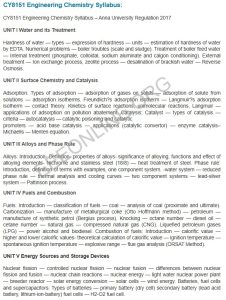CY8151 Engineering Chemistry Syllabus:
CY8151 Engineering Chemistry Syllabus – Anna University Regulation 2017
UNIT I Water and its Treatment
Hardness of water — types — expression of hardness — units — estimation of hardness of water by EDTA. Numerical problems — boiler troubles (scale and sludge). Treatment of boiler feed water — Internal treatment (phosphate, colloidal, sodium aluminate and calgon conditioning). External treatment — Ion exchange process, zeolite process — desalination of brackish water — Reverse Osmosis.
UNIT II Surface Chemistry and Catalysis
Adsorption: Types of adsorption — adsorption of gases on solids — adsorption of solute from solutions — adsorption isotherms. Freundlich?s adsorption isotherm — Langmuir?s adsorption isotherm — contact theory. Kinetics of surface reactions, unimolecular reactions, Langmuir — applications of adsorption on pollution abatement. Catalysis: Catalyst — types of catalysis — criteria — autocatalysis — catalytic poisoning and catalytic
promoters — acid base catalysis — applications (catalytic convertor) — enzyme catalysis– Michaelis — Menten equation.
UNIT III Alloys and Phase Rule
Alloys: Introduction- Definition- properties of alloys- significance of alloying, functions and effect of alloying elements- Nichrome and stainless steel (18/8) — heat treatment of steel. Phase rule: Introduction, definition of terms with examples, one component system. -water system — reduced phase rule — thermal analysis and cooling curves — two component systems — lead-silver system — Pattinson process.
UNIT IV Fuels and Combustion
Fuels: Introduction — classification of fuels — coal — analysis of coal (proximate and ultimate). Carbonization — manufacture of metallurgical coke (Otto Hoffmann method) — petroleum — manufacture of synthetic petrol (Bergius process). Knocking — octane number — diesel oil — cetane number — natural gas — compressed natural gas (CNG). Liquefied petroleum gases (LPG) — power alcohol and biodiesel. Combustion of fuels: Introduction — calorific value — higher and lower calorific values- theoretical calculation of calorific value — ignition temperature — spontaneous ignition temperature — explosive range — flue gas analysis (ORSAT Method).
UNIT V Energy Sources and Storage Devices
Nuclear fission — controlled nuclear fission — nuclear fusion — differences between nuclear fission and fusion — nuclear chain reactions — nuclear energy — light water nuclear power plant — breeder reactor — solar energy conversion — solar cells — wind energy. Batteries, fuel cells and supercapacitors: Types of batteries — primary battery (dry cell) secondary battery (lead acid battery, lithium-ion-battery) fuel cells — H2-O2 fuel cell.

